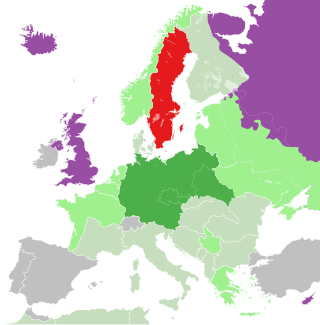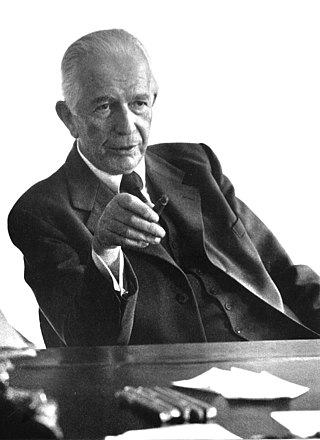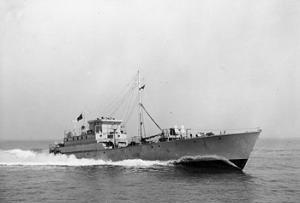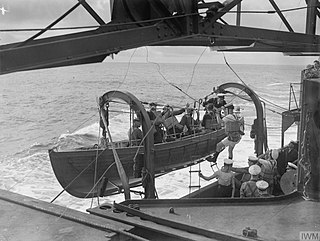Related Research Articles

AB SKF is a Swedish bearing and seal manufacturing company founded in Gothenburg, Sweden, in 1907. The company manufactures and supplies bearings, seals, lubrication and lubrication systems, maintenance products, mechatronics products, power transmission products, condition monitoring systems and related services globally.
A neutral country is a state that is neutral towards belligerents in a specific war or holds itself as permanently neutral in all future conflicts. As a type of non-combatant status, nationals of neutral countries enjoy protection under the law of war from belligerent actions to a greater extent than other non-combatants such as enemy civilians and prisoners of war. Different countries interpret their neutrality differently: some, such as Costa Rica have demilitarized, while Switzerland holds to "armed neutrality", to deter aggression with a sizeable military, while barring itself from foreign deployment.
The industrialization of Sweden began during the second half of the nineteenth century. The industrial breakthrough occurred in the 1870s during the international boom period, and it carried on through the decades in response to the growing demand of the home market. By the end of this period, the first multinational companies based on advanced technology had emerged.

Sweden maintained its policy of neutrality during World War II. When the war began on 1 September 1939, the fate of Sweden was unclear. But by a combination of its geopolitical location in the Scandinavian Peninsula, realpolitik maneuvering during an unpredictable course of events, and a dedicated military build-up after 1942, Sweden kept its official neutrality status throughout the war. At the outbreak of hostilities, Sweden had held a neutral stance in international relations for more than a century, since the end of the Napoleonic Wars in 1814 and the invasion of Norway.

A blockade runner is a merchant vessel used for evading a naval blockade of a port or strait. It is usually light and fast, using stealth and speed rather than confronting the blockaders in order to break the blockade. Blockade runners usually transport cargo, for example bringing food or arms to a blockaded city. They have also carried mail in an attempt to communicate with the outside world.
Swedish iron ore was an important economic and military factor in the European theatre of World War II, as Sweden was the main contributor of iron ore to Nazi Germany. The average percentages by source of Nazi Germany’s iron ore procurement through 1933–43 by source were: Sweden: 43.0 Domestic production (Germany): 28.2 France: 12.9. Within the German military the Navy was most dependent on Swedish steel as an absolute necessity to the German war effort, according to their grand admiral. It has also been argued that the Swedish export helped prolong the war.
Sweden had a policy of neutrality in armed conflicts from the early 19th century, until 2009, when it entered into various mutual defence treaties with the European Union (EU), and other Nordic countries. The policy originated largely as a result of Sweden's involvement in the Napoleonic Wars, during which over a third of the country's territory was lost in the Finnish War (1808–1809), including the traumatic loss of Finland to Russia, which it remained part of until Finland gained independence in 1917. Resentment towards the Swedish king Gustav IV Adolf, who had consistently pursued an anti-Napoleonic policy and thereby caused the war, precipitated a coup d'état known as the Coup of 1809. The new regime deposed the king and introduced the Instrument of Government (1809), later formulating a new foreign policy that became known as The Policy of 1812.

During World War I and World War II, Switzerland maintained armed neutrality, and was not invaded by its neighbors, in part because of its topography, much of which is mountainous. Germany was a threat, and Switzerland built a powerful defense. It served as a "protecting power" for the belligerents of both sides, with a special role in helping prisoners of war. The belligerent states made it the scene for diplomacy, espionage, and commerce, as well as being a safe haven for 300,000 refugees.
Economic warfare or economic war is an economic strategy used by belligerent states with the goal of weakening the economy of other states. This is primarily achieved by the use of economic blockades. Ravaging the crops of the enemy is a classic method, used for thousands of years.

Assar Thorvald Nathanael Gabrielsson was a Swedish industrialist and co-founder of Volvo.

The neutral powers were countries that remained neutral during World War II. Some of these countries had large colonies abroad or had great economic power. Spain had just been through its civil war, which ended on 1 April 1939 —a war that involved several countries that subsequently participated in World War II.

Foreign relations of the Axis powers includes states which were not officially members of the Axis but had relations with one or more Axis members.
HM Motor Gun Boat 2007 was a motor gunboat operated by Royal Navy Coastal Forces during the Second World War. She was initially built as one of eight gunboats ordered by the Turkish Navy, but which went on to see service in the North Sea as fast blockade runners. She was initially classed as the merchant vessel Gay Corsair, crewed by men of the merchant navy and sailing under the red ensign. She became HM Motor Gunboat 507 after being acquired by the Royal Navy, and finally HM Motor Gun Boat 2007. She was wrecked under this name in 1945.

Gay Viking was a blockade runner of the British Merchant Navy. Originally under construction as a Motor Gun Boat, Gay Viking was one of eight vessels that were ordered by the Turkish Navy, but were requisitioned by the Royal Navy to serve with Coastal Forces during the Second World War. Originally intended to be HMMGB 506, the vessel was instead completed as a blockade runner for the Merchant Navy and named Gay Viking. She operated out of Hull on two separate operations to the Scandinavian countries. She was one of the more successful of her group, but was lost in a collision while returning from one of these operations. Reports indicate that she may have been salvaged after this and gone on to sail for a considerable number of years as a civilian vessel.

The Blockade of Germany (1939–1945), also known as the Economic War, involved operations carried out during World War II by the British Empire and by France in order to restrict the supplies of minerals, fuel, metals, food and textiles needed by Nazi Germany – and later by Fascist Italy – in order to sustain their war efforts. The economic war consisted mainly of a naval blockade, which formed part of the wider Battle of the Atlantic, but also included the bombing of economically important targets and the preclusive buying of war materials from neutral countries in order to prevent their sale to the Axis powers.

Operation Rubble in January 1941, was a British blockade running operation during the Second World War, in which five Norwegian merchant ships escaped from neutral Sweden to Britain through a Nazi German blockade of the Skagerrak, carrying valuable cargoes of specialised steel products.
Ovako AB is a European manufacturer of engineering steel for customers e.g. in the bearing, transportation and manufacturing industries. Since 2018, Ovako has been owned by Nippon Steel Corporation.

The relation between Germany and Sweden has a long historical background. The relationship is characterized by exchanges between the neighboring countries of the Baltic Sea in the 14th century. Both countries are members of the European Union, NATO, United Nations, OSCE, Council of the Baltic Sea States and the Council of Europe. Germany has given full support to Sweden's membership of the European Union. Germany strongly supported Sweden's NATO membership during the latter's accession process. Germany has an embassy in Stockholm. Sweden has an embassy in Berlin.
Operation Safehaven (1944–48) was an intelligence program developed by the United States during the Second World War to prevent Nazi Germany and Axis partners of the Third Reich from hiding assets, in particular in neutral countries, for use after the war The program was designed and carried out by the US partnered with Great Britain and France. The program began in 1944 with Nazi defeat looming and evidence that Germany was covertly transferring sources of capital to neutral countries to escape war reparations and potentially aid a resurgence of the regime in the post-war period.
Sweden, following its long-standing policy of neutrality since the Napoleonic Wars, remained neutral throughout World War I between 28 July 1914 and 11 November 1918. However, this neutrality was not maintained without difficulty and Sweden at various times sympathised with different parties in the conflict.
References
- ↑ Hägglöf, M. Gunnar. "A Test of Neutrality: Sweden in the Second World War." International Affairs (1960): 153-167.
- ↑ Christian Leitz (2000). Nazi Germany and Neutral Europe During the Second World War. Manchester University Press. p. 64ff. ISBN 978-071905-068-8.
- ↑ Did Swedish Ball Bearings Keep the Second World War Going? Re‐evaluating Neutral Sweden’s Role
- ↑ RA UDA/1920ds/HP64Ua/2897, file marked “Juli 1943 – Mars 31 1944,” table marked “SKF:s Totalexport Exkl. Maskiner och Gängtappar under Aren 1938 ‐ 1942,” dated 19 July 1943
- ↑ Golson, Eric Bernard. The Economics of Neutrality: Spain, Sweden and Switzerland in the Second World War (PDF). The London School of Economics and Political Science.
- ↑ Leitz, Christian (2000). Nazi Germany and Neutral Europe During the Second World War. Manchester University Press. p. 75. ISBN 978-071905-068-8.
- ↑ Golson, Eric Bernard. The Economics of Neutrality: Spain, Sweden and Switzerland in the Second World War (PDF). The London School of Economics and Political Science. page 3.